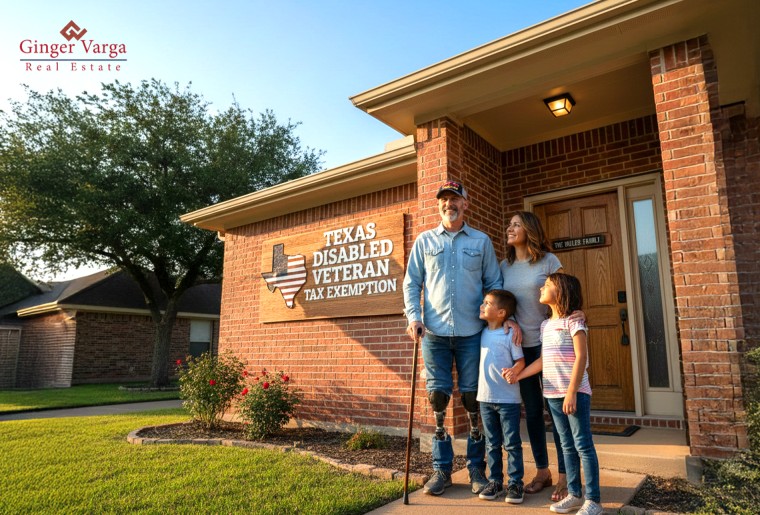If you’re a veteran or active service member planning to buy a home in Texas, you’ve likely come across the Difference Between Texas Vet Loan and VA Loan-two powerful mortgage options. While both are designed to make homeownership more affordable for veterans, the key difference lies in who offers the loan and how the benefits apply.
A VA Loan is a federal program backed by the U.S. Department of Veterans Affairs that helps eligible veterans, active-duty members, and surviving spouses purchase homes with no down payment, no private mortgage insurance (PMI), and competitive interest rates—anywhere in the United States.
In contrast, a Texas Vet Loan is a state-specific program managed by the Texas Veterans Land Board (VLB) that provides below-market interest rates and additional financial incentives exclusively for Texas residents who have served in the military. In many cases, veterans can even combine both programs to enjoy the benefits of federal backing along with Texas’s lower interest rates.
In this blog, we’ll break down both loan options in detail, explore their eligibility requirements, benefits, and drawbacks, and help you decide which one is the best fit for your homeownership goals in Texas.
What is a VA Loan?
A VA loan is a mortgage choice backed by the U.S. Department of Veterans Affairs (VA). Veterans, active service members, and surviving spouses can easily purchase property with the credit form.
This home financing option offers up to 100% financing of the home’s value. Eligible borrowers can use the funds to build or purchase a house, or to repair or improve a property.
The funds can also be used to refinance an existing mortgage. It is imperative to understand that the VA establishes only the standards and terms and provides loan backing.
You receive the funds from a private lender, such as a mortgage company or a bank.
Key Features of VA Loan
For those who have served the country, the Texas VA loan offers a powerful tool for homeownership.
Here are some of the top VA loan benefits that make the borrowing process convenient-
- No Down Payment: Eligible buyers can purchase a home without worrying about a down payment. A VA loan covers up to 100% of the purchase price.
- Save on PMI Expenses: You don’t need to worry about paying private mortgage insurance (PMI). This feature effectively reduces your monthly expenses.
- Minimal Interest Rates: This mortgage form allows you to make substantial savings on interest rates. Repayment rates are often lower than those for conventional loans.
- Lower Closing Costs: This protects the buyer’s out-of-pocket expenses at the closing. You don’t need to pay excessive fees set by the lending organizations.
- More Straightforward Credit Guidelines: The main goal of approving VA loans is to make home buying easier for veterans, so they set forgiving, flexible credit underwriting requirements.
Learn More: What Is the Disabled Veteran Property Tax Exemption?
Eligibility for VA Loan
Veterans and service members must meet specific requirements to apply for the loan. They must meet the basic service and time-in-service requirements to be eligible to borrow.
You must get a Certificate of Eligibility (COE), an official document issued by the VA that verifies your eligibility. Ideally, no minimum credit score is set against the loan.
Depending on their guidelines, certain lending institutions may require a FICO score of 620 or higher. It is always better to read the terms and conditions thoroughly before applying for the finance.
Before approving the funds, a lender will also evaluate your employment stability, repayment ability, and creditworthiness.
Apart from the mentioned requirements, you need to fulfill specific eligibility criteria like:
- You must have served at least 90 days of active duty during wartime.
- Loan applicants must have completed 181 days of active duty during peacetime.
- Must have served at least six years in the National Guard or Reserves or 90 days under Title 32 orders.
- You were honorably discharged or are currently serving.
- Surviving spouses of eligible veterans who qualify for the specific conditions.
Steps to Apply
Buying a home with a VA loan requires careful planning. You must arrange specific documents and evaluate your current finances to make a decision.
The following are the steps you can follow to apply for a VA loan easily:
- Start the process by obtaining a Certificate of Eligibility (COE) through the VA.
- Apply for the loan with a VA-authorized lender and get approved.
- Check whether the selected property meets the VA appraisal standards.
- Submit your supporting documents mentioned in the VA and lending institution’s guidelines.
- Complete the underwriting to purchase your dream abode.
What is a Texas Vet Loan?
The Texas Vet Loan is a state-administered lending program managed by the Texas Veterans Land Board (VLB). It’s offered to eligible and qualified veterans who are solely Texas residents.
It is not a standalone credit form but an enhancement to the VA loan. The program aims to provide lower interest rates and additional financial incentives.
Learn More: Texas Disabled Veteran Benefits
Active-duty military members, Veterans, and members of the National Guard or Reserves can apply for the credit. The interest rates for Texas Vet Loans are updated weekly, so there is room to save substantially.
Key Features of Texas Vet Loan
Texas Vet Loan offers low-interest home loans to veterans looking to purchase or refinance their homes in Texas.
These programs ensure that the Veterans can access the support they deserve. The following are the features that make the credit valuable.
- No Down Payment: Texas Vet loans allow borrowers to finance 100% of the home’s purchase price, so you don’t have to worry about a down payment.
- Devoid of PMI or Closing Fee: Vet loan doesn’t require paying additional private mortgage insurance or a closing fee. Eliminating the closing fee helps you save on subsequent monthly funds.
- Lower Interest Rate: The Texas Veterans Board usually sets a lower interest rate on the loan. Veterans can get up to a 0.5% interest rate reduction. It also offers a service-connected disability of 30% or higher, enhancing the benefit.
- Flexibility: The Texas Vet loan allows borrowers to use the funds for home repairs and improvements. They can choose a 15- or 30-year repayment term.
- Loan Alternatives: Borrowers can easily select from Texas Vet loan types that suit their financial positions. You can choose any one of an FHA, VA, or conventional loan.
Learn More: Eligibility Requirements for Veterans’ Property Tax
Eligibility for Texas Vet Loan
Applicants must meet the residency, service, and property-related criteria to qualify for the Texas Vet loan.
The program only applies to veterans, active-duty service members, and their families. You must submit the Certificate of Eligibility (COE) to start loan processing, provided you combine it with the VA loan.
You have to fulfill the following requirements to be eligible for a Vet loan –
- Must have served on active duty in the U.S. Armed Forces and received an honorable discharge.
- The deceased veteran’s spouse can avail the loan, provided they haven’t remarried.
- Applicant must be a Texas resident at the time of application.
- You must purchase the home and use it as your primary residence.
- Newly constructed properties must meet the EPA’s Energy Star rating guidelines.
Steps to Apply
Getting a Texas Vet loan is relatively simple. Most lenders offer a simple application process and require basic information about your military background.
Check: Step-by-Step Application Process – Texas Property Tax Exemptions for Veterans
However, they analyze your credit history, income stability, and repayment ability before processing the funds.
The following are the steps to apply for the Vet loan –
- Start by confirming your VA eligibility and obtaining the COE.
- Select a reliable lender that has been approved to offer Texas Vet Loans.
- Submit the proof of your Texas residency and military service.
- Lock in the following week’s VLB interest rate.
- Complete the application and wait for the approval.
- Get the ownership of your Texas home.
Texas Vet Loan vs. VA Loan: Key Differences
While both the VA loan and Texas Vet loan cater to the veterans, they serve distinctive benefits.
The primary difference between these credit forms lies in the location-specific requirements. A Texas veteran home loan is only applicable for individuals who reside in Texas, while there are no such criteria against the VA loan.
The following are the pointers to help you understand the difference between Texas Vet loan and VA loan.
| Features | VA Loan | Texas Vet Loan |
| Interest Rates | Rates may vary according the lending institution and borrower’s credibility. | Rates are set and managed by the VLB. It is usually lower than VA loans. |
| Purpose | Used for buying a house. | Used for buying a house, land, or home improvements. |
| Location- Specific | There are no location-specific rules set against the loan eligibility. | The applicant needs to be a resident of Texas with valid proof. |
| Loan Limits | There is no government-set maximum loan amount. | As of 2025, the loan limit has been set to up to $806,500. |
| Funding Fee | It requires a one-time funding fee made at closing. | Doesn’t require any form of funding fee. |
| Disability Discount | There are additional discounts for disabled applicants. | Veterans with a 30% or higher service-connected disability get an extra 0.5% interest rate reduction. |
Can You Use Both a VA Loan and a Texas Vet Loan Together?
While checking the mortgage eligibility comparison, combining the loans likely occurred to you.
It is, in fact, a possibility as the Texas Vet Loan works in conjunction with a VA Loan.
Veterans who qualify for both credit forms can use the VA Loan’s federal guarantee and underwriting framework. This method allows them to leverage their savings to take advantage of Texas VLB’s lower interest rates.
Learn More: Can I Have 2 VA Mortgages at the Same Time?
This facility allows eligible Texas veterans to enjoy the benefits offered by the state and federal governments.
However, you can’t combine the full benefits of both loans into a single loan. You can only use it in a complementary way. In this regard, reading the lending institution’s guidelines can offer valuable insight.
Pros and Cons of a VA Loan
In the current economy, buying a house can be financially straining. This is why all the factors need to be considered.
For Veterans, the VA loan can be a powerful tool to achieve homeownership, but it comes with long-term obligations.
Hence, deciding to avail of a loan should depend on financial stability and risk tolerance.
In this regard, assessing the pros and cons of the loan can help you make a confident decision.
Pros:
- No need for down payment and PMI.
- Easy to access from anywhere in the U.S.
- The credit is reusable and refinancable.
- Easier qualification with flexible credit standards.
- Comes with strong federal backing.
Cons:
- Lenders may apply a VA Funding Fee.
- The approval process can be strict and may take longer.
- Applicable for houses used as a primary residence.
- Some brokers may hesitate to sell the property backed by the federal government.
Pros and Cons of a Texas Vet Loan
A Texas vet loan allows veterans to buy a beautiful home at a low interest rate, helping them realize their dream of retiring in a comfortable home.
However, purchasing a house backed by the State government has pros and cons. Understanding the obligations clearly will help you make a wise choice.
This decision will protect your financial future while enhancing the benefits you have earned.
Pros:
- It offers lower interest rates than standard VA loans.
- Offers additional savings for disabled veterans.
- Helps save significant funds by removing penalties and PMI.
- Benefits for both the state government and lending institutions.
Cons:
- Limited to buying homes in Texas only.
- It cannot be used with a VA Loan.
- Doesn’t allow any refinancing options.
Which Loan is Right for You?
Finding the proper funding for your home should depend on the benefits that align with your long-term goals. For eligible veterans, active-duty service members, and Texas residents, VA loans and Vet loans offer significant advantages.
The right choice will depend on your situation and location preference. Make sure to assess all the factors and compare loans before deciding.
- Location Flexibility: The VA loan suits borrowers who prefer nationwide flexibility and simple qualification, while the Texas Vet loan is well-suited for Texas residents.
- Good Savings: If you are looking for minimal upfront expense and predictable monthly repayments, then opt for a VA loan. It often requires no down payment and private mortgage insurance, which can lead to good savings.
- Higher Loan Amount: If you need a loan exceeding $806,500, VA loans can be a good option. However, if you want a lower amount, get a Vet loan.
If you have a service-connected disability, combining both programs maximizes your financial advantage.
Common Misconceptions about VA and Texas Vet Loans
Though VA and Vet loans offer government-backed benefits, the lack of awareness leads to several misconceptions.
Many borrowers hesitate to explore these programs due to confusion and stigma. This leads to dependence on regular home loans that charge high interest rates.
They require borrowers to present a plethora of documents, delaying loan disbursement. Hence, it is essential to learn more about the VA and Texas Vet loans.
Clarifying the myths will help borrowers make the right choice and make the most out of the benefits.
The following are the false myths on veteran loans spread by the ignorant
- VA Loans are applicable for first-time homebuyers.
- Texas Vet loans are restricted to land purchases
- Only veterans can apply for VA and VE loans.
- VA mortgages can be used multiple times under the right conditions.
- These finances have an extended closing time.
- Since they are government-backed loans, approval will take longer.
- Texas Vet loans involve more expenses than conventional advances.
- The application process for these credits is complex and time-consuming.
Own Your Dream Residence with the Help of Ginger Varga
By now, you know the difference between a VA loan and a Texas Vet loan. For Texas veterans, the path to homeownership is uniquely supported by a dual federal and state benefits system.
With their flexible terms, both loans help make targeted savings and gain multiple Veteran benefits. However, you need a reliable team to make the most out of the loans.
Ginger Varga will work closely with you to find the right home that fits your budget and future goals. With our preferred VA lender, we make your pre-qualification process easier.
From locating your perfect property to navigating negotiations, Ginger will guide you.
Why wait to own your dream property?
Connect with Ginger Varga today to maximize your VA loan benefits and obtain the keys to your dream home.
Difference Between Texas Vet Loan and VA Loan: FAQ
Q: Can I purchase a second home or investment property using a Texas Vet Loan or VA Loan?
Ans: You can’t use a VA loan or a Texas Vet loan to buy a second property. Both loans approve credit against the primary residence.
Q: How do credit score requirements differ between Texas Vet Loans and VA Loans?
Ans: There are specific credit score limits set for Texas Vet loans. However, you may need a minimum score of 620 for a VA loan. The lenders and their policies will set the requirement.
Q: Are specific property types ineligible for Texas Vet Loans or VA Loans?
Ans: Yes, some property types are ineligible for Texas Vet and VA loans. These programs have specific guidelines for properties. The house must be a primary residence, in good condition, and comply with local building codes.
Q: What happens if I default on a Texas Vet Loan or VA Loan?
Ans: Defaulting a Texas Vet Loan or a VA Loan will result in foreclosure. Ideally, the lender will seize and sell your property to recover the loss. You will lose the ownership of your home and VA entitlement. You must wait two years before you can use the VA loan benefit again.
Q: Can non-veteran spouses or co-borrowers apply for these loans with me?
Ans: Surviving spouses of qualifying veterans and co-borrowers can apply for the loans. However, they must abide by specific rules to qualify. A spouse of the deceased can't get married to qualify for the loan.Q: How do property taxes in Texas affect the overall cost of a Texas Vet Loan?
Ans: Property taxes impact the overall cost of a Texas Vet Loan through annual payments. Ideally, homeownership's total yearly expenses include recurring property taxes. The tax rate may vary by location and property type.Q: Are there prepayment penalties for paying off a Texas Vet Loan or VA Loan early?
Ans: No prepayment penalties for paying off a Texas Vet Loan or a VA Loan early. Both of these credit programs help veterans buy a house with simple borrowing. It allows you to pay off the mortgage at any time without paying any penalty.Q: How do Texas Vet Loan and VA Loan refinancing options compare?
Ans: The main difference between Texas Vet and VA loan refinancing is the additional benefits they offer. Texas Vet loans provide a lower fixed interest rate set by the Texas Veterans Land Board. While the federal government controls the VA loan, it is accessible nationwide.Q: Can I use a Texas Vet Loan or VA Loan for a manufactured or modular home?
Ans: Yes, Texas Vet Loans and VA Loans are eligible for purchasing manufactured and modular homes. However, these properties must fulfill specific requirements. Modular homes must have a permanent foundation to be eligible.Q: What are the typical closing timelines for Texas Vet Loans compared to VA Loans?
Ans: Typically, the closing timeline for VA loans is 30–45 days, depending on appraisal, documentation, and the lender's processing speed. A Texas Vet loan may take an additional 15 to 20 business days.



